Ecological Carrying Capacity and Driving Factors of the Source Region of the Yellow River in China over the Past 30 Years
Abstract
:1. Introduction
2. Materials and Methods
Overview of the Study Region
3. Research Methods
3.1. Data Sources and Preprocessing
3.2. Land Use Dynamic Degree
3.3. Calculation of ECC
- The ecological footprint method was adopted. ECC refers to the total amount of available productive land and water resources within a specific research area over a period of time, typically one year [31,32]. The ECC equation was as follows:where BC is the ecological carrying capacity in global hectares (g ha); Ai is the area (hm2); YFi is the yield factor, which refers to the ratio of the productivity of a specific bio-productive land in one particular country or region to the average productivity of the same land in the world; and EQFi is the equilibrium factor, which is calculated as follows: the average ecological productivity of productive biological land in the world is divided by the average ecological productivity of all kinds of biologically productive land across the globe.
- AECC in the SRYR is calculated at the grid level as the basic unit, with the statistics of the AECC for each county unit being compiled accordingly [33] as follows:where BC is the total ecological carrying capacity in the unit.
- ECC and AECC classification [34].
- 4.
- When calculating the regional ecological footprint, the most critical parameters are the equilibrium factor and the yield factor. Given the challenges in obtaining yield factors and equilibrium factors, this experiment employed yield factors and equilibrium factors from similar years as conversion factors for ECC. The equilibrium factors and yield factors utilized in this study were sourced from relevant domestic and international literature [35,36,37], as detailed in Table 2 and Table 3. We selected the conversion factor of similar years as the ECC calculation data of similar years in this study.
3.4. ECC Correlation Analysis
- Redundancy Analysis of Landscape Patterns and ECC
- 2.
- Analysis of ECC Drivers
4. Results and Analysis
4.1. Changes in Land Use Types
4.1.1. Dynamic Attitude of Land Use Types
4.1.2. Spatial Distribution of Land Use Types
4.1.3. Temporal Changes in Land Use Types
4.2. Temporal and Spatial Dynamic Changes in ECC
4.2.1. Spatial Distribution of ECC at the County Scale
4.2.2. Spatial Distribution of ECC at the Source Region Scale
4.2.3. Temporal Changes in ECC at the County Scale
4.2.4. Temporal Changes in ECC at the Source Region Scale
4.3. Temporal and Spatial Dynamic Changes in AECC
4.3.1. Spatial Distribution of AECC
4.3.2. Temporal Changes in AECC
4.4. ECC Correlation Analysis Results
4.4.1. Redundancy Analysis
4.4.2. Driving Factor Analysis
5. Discussion
5.1. Exploration of Land Use Types and Conversions
5.2. Exploration of Changes in ECC and AECC
5.3. Exploring the Correlation Between Landscape Patterns and ECC
5.4. Exploring the Drivers of ECC
6. Conclusions
- (1)
- From 1990 to 2020, the area of woodland in the SRYR remained relatively stable, while the area of unused land significantly decreased. The areas of cultivated land, grassland, water bodies, and construction land increased, with grassland showing the largest increase. The main land use types experiencing area transitions were grassland and unused land, mainly distributed in western Maduo County and central Maqin County. The most significant transition occurred between 2005 and 2010, when a large amount of unused land was converted to grassland, with a conversion volume of 7382.33 km2.
- (2)
- Over the past 30 years, the ECC of the SRYR and each county has generally shown an upward trend. The ECC of grassland and construction land has increased significantly, while that of woodland has decreased. The ECC is higher in Maqin County, Maduo County, and Xinghai County, and lower in Zeku County, Gade County, and Henan County. The AECC of cultivated land and construction land initially increased and then decreased, and has shown a slow growth trend since 2005.
- (3)
- Over the past 30 years, the SRYR has shown predominantly low ECC in the west, medium ECC in the central area, and high ECC in the southern region. High AECC is concentrated in a banded distribution in the northwest, while low AECC is patchily distributed in the northern region.
- (4)
- There is a correlation between the ECC of the SRYR and various landscape-level indicators, among which COHESION, PARA_MN, and SPLIT have better explanatory power.
- (5)
- Over the past 30 years, the land use in the SRYR has been rational, with both ECC and AECC showing an increasing trend, and the ecological environment gradually improving. The population and GDP in the social factors have greatly affected the ECC of the region, which is the main driving factor of the ecological carrying capacity of the SRYR.
Author Contributions
Funding
Additional Information
Data Availability Statement
Conflicts of Interest
References
- Chun, X.; Qing, F.Y.; Zhou, H.J.; Dan, D.; Xia, Y.-Y.; Ulambadrakh, K. Effects of climate variability and land use/land cover change on the Daihai wetland of central Inner Mongolia over the past decades. J. Mt. Sci. 2020, 17, 3070–3084. [Google Scholar] [CrossRef]
- Chen, J. Influence and Evaluation of Economic Carrying Capacity in Guangdong Province from the Perspective of Trans-regional Marine Ecological Environment Flow. J. Coast. Res. 2020, 104, 682–686. [Google Scholar] [CrossRef]
- Liu, J.Y.; Ning, J.; Kuang, W.H.; Xu, X.; Zhang, S.; Yan, C.; Li, R.; Wu, S.; Hu, Y.; Du, G.; et al. Spatio-temporal pattern and new features of land use change in China from 2010 to 2015. J. Geogr. 2018, 73, 789–802. [Google Scholar] [CrossRef]
- Zhang, L.Y.; Chung, S.; Qiu, J. Ecological carrying capacity assessment of diving site: A case study of Mabul Island, Malaysia. J. Environ. Manag. 2016, 183, 253–259. [Google Scholar] [CrossRef]
- Wen, X.M.; Du, L.Y.; Dou, Y.Y.; Lu, X. Research on Ecological Carrying Capacity and Industrial Transfer in Hebei Province. Coop. Econ. Technol. 2018, 6, 32–33. [Google Scholar] [CrossRef]
- Miyake, S.; Renouf, M.; Peterson, A.; McAlpine, C.; Smith, C. Land use and environmental pressures resulting from current and future bioenergy crop expansion: A review. J. Rural. Stud. 2012, 28, 650–658. [Google Scholar] [CrossRef]
- Feng, Z.M.; Yang, Y.Z.; Jiang, D.; Yuan, G.; Ma, J.; Zhang, Z.; Zhang, H.; Liu, H.; Yan, H.; Pan, T. The compilation of natural resources balance sheet and evaluation of resources and environmental carrying capacity. J. Ecol. 2016, 36, 7140–7145. [Google Scholar] [CrossRef]
- Medved, S. Present and future ecological footprint of Slovenia-The influence of energy demand scenarios. Ecol. Model. 2006, 192, 25–36. [Google Scholar] [CrossRef]
- Yang, D.; Li, M.; Wang, F.; Lin, W.; Li, W. Ecological footprint evaluation: An empirical study of the Bohai coast of the Jing-Jin-Ji region. J. Coast. Res. 2020, 106, 407–413. [Google Scholar] [CrossRef]
- Wu, R.; Li, C.Y. Land use analysis based on three-dimensional ecological footprint model under ArcGIS-taking eastern cities of Qinghai Province as an example. Land Nat. Resour. Res. 2020, 6, 20–27. [Google Scholar] [CrossRef]
- Du, W.P.; Yan, H.M.; Feng, Z.M.; Yang, Y.; Chen, R. Study on the ecological carrying capacity of China-Nepal corridor area based on the balance between ecological supply and consumption. J. Ecol. 2020, 40, 6445–6458. [Google Scholar]
- Zhen, L.; Xu, A.; Zhao, Y.; Jijun, W.; Yunfeng, H.; Juanle, W. Ecological carrying capacity and green development in the “belt and road” initiative region. J. Resour. Ecol. 2019, 10, 569–573. [Google Scholar] [CrossRef]
- Zhang, L. Research on sustainable development of Xian city based on ecological footprint model. Can. Soc. Sci. 2020, 16, 18–24. [Google Scholar] [CrossRef]
- Su, Z.L.; Yuan, G.H.; Zhou, W. Evaluation of ecological carrying capacity of land in Anhui province based on improved three-dimensional ecological footprint model. Soil Water Conserv. Res. 2020, 27, 256–262. [Google Scholar] [CrossRef]
- Lu, Y.; Li, X.; Ni, H.; Chen, X.; Xia, C.; Jiang, D.; Fan, H. Temporal-spatial evolution of the urban ecological footprint based on net primary productivity: A case study of Xuzhou central area, China. Sustainability 2019, 11, 199. [Google Scholar] [CrossRef]
- Yue, D.X.; Chen, G.G.; Zhu, M.X.; Guo, X.; Zhou, Y.; Li, K.; Wang, D.; Guo, J.; Zeng, J. Research on ecological carrying capacity and ecological water demand of Shule River Basin in recent 20 years. J. Ecol. 2019, 39, 5178–5187. [Google Scholar] [CrossRef]
- Danis, H.; Ulucak, R.; Khan, U.D. Determinants of the ecological footprint: Role of renewable energy, natural resources, and urbanization. Sustain. Cities Soc. 2020, 54, 101996. [Google Scholar] [CrossRef]
- Yang, Y. Study on Ecological Carrying Capacity of Alpine Grassland in Qinghai-Tibet Plateau. Master’s Thesis, Hebei Normal University, Shijiazhuang, China, 2019. [Google Scholar]
- Bai, L.Y.; Rong, Y.S. Impact of climate change on water resources in the source areas of the Yangtze River and the Yellow River. Water Resour. Prot. 2012, 28, 46–50. [Google Scholar] [CrossRef]
- Gu, M.L. Analysis of ecological environment protection and sustainable utilization of water resources in the source region of the Yellow River. Gansu Agric. 2019, 9, 76–77. [Google Scholar] [CrossRef]
- Tian, S.M.; Han, B.; Liang, S.; Jing, Y.; Chen, R.; Wang, W. Discussion on water conservation in the source region of the Yellow River. J. Water Resour. Waterw. Eng. 2022, 1, 19–27. [Google Scholar] [CrossRef]
- Liang, W.T.; Wei, L.Y.; Liu, Y.; Yin, H.; Han, Z. The increase of land water reserves in the source region of the Yellow River in recent 20 years and its possible causes. China Rural. Water Hydropower 2022, 35, 138–147. [Google Scholar]
- Lu, S.J.; Si, J.H.; Qi, Y.; Wang, Z.; Wu, X.; Hou, C. Distribution characteristics of TOC, TN and TP in the wetland sediments of Longbao Lake in the San-Jiang head waters. Acta Geophys. 2016, 64, 2471–2486. [Google Scholar] [CrossRef]
- Lu, S.J.; Si, J.H.; Hou, C.Y.; Li, Y.-S.; Wang, M.-M.; Yan, X.-X.; Xie, M.; Sun, J.-X.; Chen, B.-J.; Li, S.-S. Spatiotemporal distribution of nitrogen and phosphorus in alpine lakes in the Sanjiangyuan Region of the Tibetan Plateau. Water Sci. Technol. 2017, 76, 396–412. [Google Scholar] [CrossRef]
- Wang, H.H.; Zeng, W.H.; Ma, B.G.; Li, Q. Study on multi-objective optimization model of ecological carrying capacity uncertainty of protected land-taking maduo county, the source area of the Yellow River as an example. China Environ. Sci. 2021, 41, 1300–1310. [Google Scholar] [CrossRef]
- Wang, Y.; Li, Y.H.; Sun, X.Y. Impact of climate change on the ecological environment of the Yellow River source region. Grassl. Sci. 2015, 32, 539–551. [Google Scholar] [CrossRef]
- Wang, L.J.; Guo, N.; Sha, S.; Yang, Y.; Wang, X.; Hu, D. Effects of land cover type conversion on water exchange and climate change in the source area of the Yellow River. Theor. Appl. Climatol. 2022, 149, 525–536. [Google Scholar] [CrossRef]
- Fu, X.; Yang, X.; Dong, Q.; Zhang, C.; Liu, W.; Yu, C.; Zhang, X.; Su, C.; Shi, G.; Yang, Z.; et al. Response of major species in alpine grassland to grazing. Grassl. Sci. 2021, 38, 531–543. [Google Scholar] [CrossRef]
- Zhao, Y.J.; Li, Y.B.; Shao, J.G. Ecological risk assessment of small watersheds in the Three Gorges Reservoir Area based on land use change—The case of Caotang Creek. J. Nat. Resour. 2013, 28, 944–956. [Google Scholar] [CrossRef]
- Zhu, M.S. Research on Land Use Change and Its Ecological Effect in the Lower Reaches of the Yellow River Based on GEE. Master’s Thesis, Shandong University of Architecture, Jinan, China, 2023. [Google Scholar]
- Yue, D.; Xu, X.; Li, Z.; Hui, C.; Li, W.; Yang, H.; Ge, J. Spatiotemporal analysis of ecological footprint and biological capacity of Gansu, China 1991–2015: Down from the environmental cliff. Ecol. Econ. 2005, 58, 393–406. [Google Scholar] [CrossRef]
- Yan, J.F.; Wang, M.H.; Su, F.Z.; Zhang, X.; Gao, S.; Xu, M. Changes in land cover and ecological stress in Borneo based on remote sensing and an ecological footprint method. Landsc. Ecol. Eng. 2020, 16, 319–333. [Google Scholar] [CrossRef]
- Hu, X.K.; Wei, H.D.; Chen, F.; Xu, X.; Zhou, J.; Tang, J. Dynamic changes of alpine wetland landscape in Maqu County, the source region of the Yellow River. J. Southwest For. Univ. 2012, 32, 43–47+111. [Google Scholar] [CrossRef]
- Liu, C.H.; Wang, P.L.; Wen, T.T.; Yu, D.; Bai, W. Study on the temporal and spatial law of climate change in the source region of the Yellow River from 1960 to 2019. Arid Area Res. 2021, 38, 9–10. [Google Scholar] [CrossRef]
- Zeng, J.J. Study on Ecological Carrying Capacity and Ecological Water Demand of Shule River Basin in the Context of Landscape Pattern Change. Ph.D. Thesis, Lanzhou University, Lanzhou, China, 2018. [Google Scholar]
- Liu, M.C.; Li, W.H.; Xie, G.D. Measurement of yield factor of China’s ecological footprint based on net primary productivity. J. Ecol. 2010, 29, 592–597. [Google Scholar] [CrossRef]
- Wackernagel, M.; Rees, W.E. Our Ecological Footprint: Reducing Human Impact on the Earth; New Society Publishers: Gabriola Island, BC, Canada, 1997; Volume 1. [Google Scholar] [CrossRef]
- WWF. Living Planet Report 2014: Species and Spaces, People and Places; World Wildlife Fund: Surrey, UK, 2014; Available online: http://awsassets.panda.org/downloads/lpr_living_planet_report_2014.pdf (accessed on 16 May 2022).
- WWF. Living Planet Report 2002: Resource Destruction: The Earth is Overdrawn; World Wildlife Fund: Surrey, UK, 2002; Available online: https://wwfint.awsassets.panda.org/downloads/lpr2002.pdf (accessed on 16 May 2022).
- Guo, X.N.; Liu, X.N.; Song, Y.B.; Ning, X. A study on the dynamics of landscape pattern in Dongfang City, Hainan Province based on Fragstats. Zhongnan For. Surv. Plan. 2016, 35, 30–33+52. [Google Scholar] [CrossRef]
- Zhu, Y.G. Analysis of spatial and temporal evolution and driving factors of green total factor productivity in cities in the Yellow River Basin. Sci. Ind. 2021, 21, 61–69. [Google Scholar] [CrossRef]
- Cao, X.J. An analysis of the operating performance of listed banks in China-an approach based on principal component analysis, factor analysis and cluster analysis. J. Cebu Acad. 2016, 31, 25–29. [Google Scholar] [CrossRef]
- Qiao, B.; Zhu, C.X.; Cao, X.Y.; Xiao, J.-S.; Zhaxi, L.-D.; Yan, Y.-Q.; Chen, G.-Q.; Shi, F.-F. Spatial autocorrelation analysis of land use and ecosystem service value in Maduo county, Qinghai under grid scale. J. Appl. Ecol. 2020, 31, 1660–1672. [Google Scholar] [CrossRef]
- Zhang, L. Spatial-Temporal Dynamic Changes of Land Use and Vegetation Index and Its Driving Factors in the Source Region of the Yellow River in Recent 32 Years. Ph.D. Thesis, Xi’an University of Technology, Xi’an, China, 2017. [Google Scholar]
- Zhang, Y.L.; Liu, L.S.; Wang, Z.F.; Bai, W.; Ding, M.; Wang, X.; Yan, J.; Xu, E.; Wu, X.; Zhang, B.; et al. Temporal and spatial characteristics of land use and cover change in Qinghai-Tibet Plateau. Sci. Bull. 2019, 64, 2865–2875. [Google Scholar]
- Zhang, Y.S. Water and soil loss and control measures in the headwaters of the Yellow River. Qinghai Agric. For. Sci. Technol. 2007, 2, 83–84+86. [Google Scholar] [CrossRef]
- Li, R.S.; Shao, Z.T.; Zhang, H.H.; An, Z. Study on the temporal and spatial evolution and causes of desertification in the upper reaches of the Yellow River in recent 30 years. World Geol. 2014, 33, 494–503. [Google Scholar] [CrossRef]
- Wu, X.F.; Li, G.X.; Pan, X.P.; Wang, Y.; Zhang, S.; Liu, F.; Shen, Y. Response of vegetation coverage in the source region of the Yellow River to temperature and precipitation. Resour. Sci. 2015, 37, 512–521. [Google Scholar]
- Yao, L.; Wu, Q.M. Characteristics of climate change in Qinghai-Tibet Plateau. Meteorol. Sci. Technol. 2002, 30, 163–164+143. [Google Scholar] [CrossRef]
- Guan, Y.L. Study on the Change of Global Climate Landscape Pattern and Its Impact on the Surface Water Resources of Qinghai-Tibet Plateau. Ph.D. Thesis, North China Electric Power University, Beijing, China, 2021. [Google Scholar]
- Shao, Q.Q.; Fan, J.W.; Liu, J.; Huang, L.; Cao, W.; Xu, X.; Ge, J.; Wu, D.; Li, Z.; Gong, G.; et al. Ecological Effect Evaluation of the First Phase of Sanjiangyuan Ecological Protection and Construction Project. J. Geogr. 2016, 71, 3–20. [Google Scholar] [CrossRef]
- Li, H.M.; Li, W.Q.; Yuan, Y.; Zhang, Z.J. Study on land use/cover change and its driving factors in cities and towns in eastern Qinghai Province. Sci. Technol. Innov. 2021, 27, 118–121. [Google Scholar] [CrossRef]
- Wang, M.L. Protecting lawn ecological environment and promoting sustainable development of ecological and organic animal husbandry in Huangnan. Peasant Staff 2021, 119–120. [Google Scholar]
- Chen, Q.; Zhang, Y.L.; Liu, F.G.; Zhou, Q.; Wang, S.; Cheng, Y.; Guo, R.; Zhi, Z.; Xu, H. Review of land use change and its impact in the source region of the Yellow River Basin. Resour. Sci. 2020, 42, 446–459. [Google Scholar] [CrossRef]
- Yin, B.K.; Cao, X.Y.; Zhang, J.G.; Zhang, D.; Wang, X. Dynamic changes of soil erosion in the source region of the Yellow River from 1999 to 2018. Bull. Soil Water Conserv. 2020, 40, 216–220+325. [Google Scholar] [CrossRef]
- Qinghai Provincial Department of Finance. Qinghai: Improving fiscal policy measures-supporting the protection of Sanjiangyuan. China Financ. 2020, 3, 66–68. [Google Scholar] [CrossRef]
- Mao, J.H.; Wu, Q.; Zhu, M.H.; Lu, C. Effects of Environmental Regulation on Green Total Factor Productivity: An Evidence from the Yellow River Basin, China. Sustainability 2022, 14, 2015. [Google Scholar] [CrossRef]
- Zhong, M.C. Ecological carrying state and protection responsibility of ecological functional areas in the development of the Yellow River Basin. Hebei Acad. J. 2021, 41, 182–189. [Google Scholar]
- Qinghai Provincial People’s Government. Environmental protection of Qinghai province in the 13th five-year plan. Qinghai Sci. Technol. 2016, 26–30. Available online: http://www.qinghai.gov.cn/ (accessed on 13 May 2022).
- Zhao, S.X. The practice of high-quality development and high-quality living in Qinghai. J. Natl. Teach. Coll. Qinghai Norm. Univ. 2020, 31, 54–58. [Google Scholar] [CrossRef]
- Xin, Y.J.; Zhou, D.M.; Jin, Y.L.; Ma, J.; Zhang, J. Study on the spatio-temporal evolution characteristics and driving forces of ecological carrying capacity in Shule River Basin. Remote Sens. Inf. 2021, 36, 18–28. [Google Scholar] [CrossRef]
- Ji, Y.M.; Wang, X.W.; Liang, B.C.; Hong, L. Analysis of dynamic changes of land use and ecological carrying capacity in northern Shaanxi. China Popul. Resour. Environ. 2011, 21, 271–274. [Google Scholar] [CrossRef]
- Zhuo, Y.; Wang, X.W.; Xu, J.F.; Yang, N. Analysis of dynamic changes of land use and ecological carrying capacity in southern Shaanxi. Anhui Agric. Sci. 2009, 37, 1266–1270. [Google Scholar] [CrossRef]
- Wu, Y. Evaluation of the Implementation Effect of Grassland Ecological Protection Subsidy and Reward Policy in the Source Area of the Yellow River. Ph.D. Thesis, Lanzhou University, Lanzhou, China, 2019. [Google Scholar]
- Zhang, Y.X.; Fan, J.W.; Wang, S.Z.; Zhang, H.; Guan, H. Ecological carrying capacity and ecological security evaluation and analysis of limiting factors in Sanjiangyuan region. Acta Vet. Sin. 2019, 39, 360–372. [Google Scholar] [CrossRef]
- Gao, Y.L.; Lin, H.L.; Zhou, Z.Y.; Wei, Y. Ecological footprint of sustainable development in Sanjiangyuan region. Lawn Sci. 2019, 36, 11–19. [Google Scholar] [CrossRef]
- Huang, Y.Q. Analysis of land use change and driving forces in the Yellow River Basin from 1995 to 2018. J. Northwest For. Univ. 2022, 37, 113–121. [Google Scholar] [CrossRef]
- Huang, X. Analysis of Landscape Pattern Changes and Ecological Carrying Capacity of Dongting Lake Area in the Past 20 Years. Ph.D. Thesis, Hunan Agricultural University, Changsha, China, 2017. [Google Scholar]
- Lu, Y.; Wei, F.; Luo, C.C. The influence of landscape pattern on habitat quality in Wanning City. Tropical Agric. Sci. 2023, 43, 63–69. [Google Scholar]
- Peng, J.J.; Xu, L.P.; Cao, C. Spatial and temporal evolution of glacial landscape patterns in the Yarkand River basin from 1991–2017. J. Ecol. 2022, 42, 8265–8275. [Google Scholar] [CrossRef]
- Xu, M.J.; Cheng, X.J.; Quan, Q.; Yan, D.; Zhang, F. Evolution of runoff and analysis of its drivers in the source region of the Yellow from 1960 to 2019. China Soil Water Conserv. 2023, 63–67. [Google Scholar] [CrossRef]
- Wang, A.Q. Research on Land Ecological Security Evaluation and Influencing Factors in the Yellow River Basin. Ph.D. Thesis, Xi’an University of Technology, Xi’an, China, 2024. [Google Scholar]
- Lu, L. Analysis of Land Use/Cover Change Characteristics and Influencing Factors in the Yellow River Basin. Ph.D. Thesis, Lanzhou University, Lanzhou, China, 2024. [Google Scholar]
- Li, Y.H. Study on the Coupling and Coordination of New Urbanization and Resource and Environmental Carrying Capacity of the Pearl River Delta Urban Agglomeration. Ph.D. Thesis, Guangzhou University, Guangzhou, China, 2022. [Google Scholar]
- Zhao, J. Analysis of Ecological Environment Evolution and Driving Forces of Sanjiangyuan Based on RS and GIS Technology. Ph.D. Thesis, Jilin University, Changchun, China, 2009. [Google Scholar]
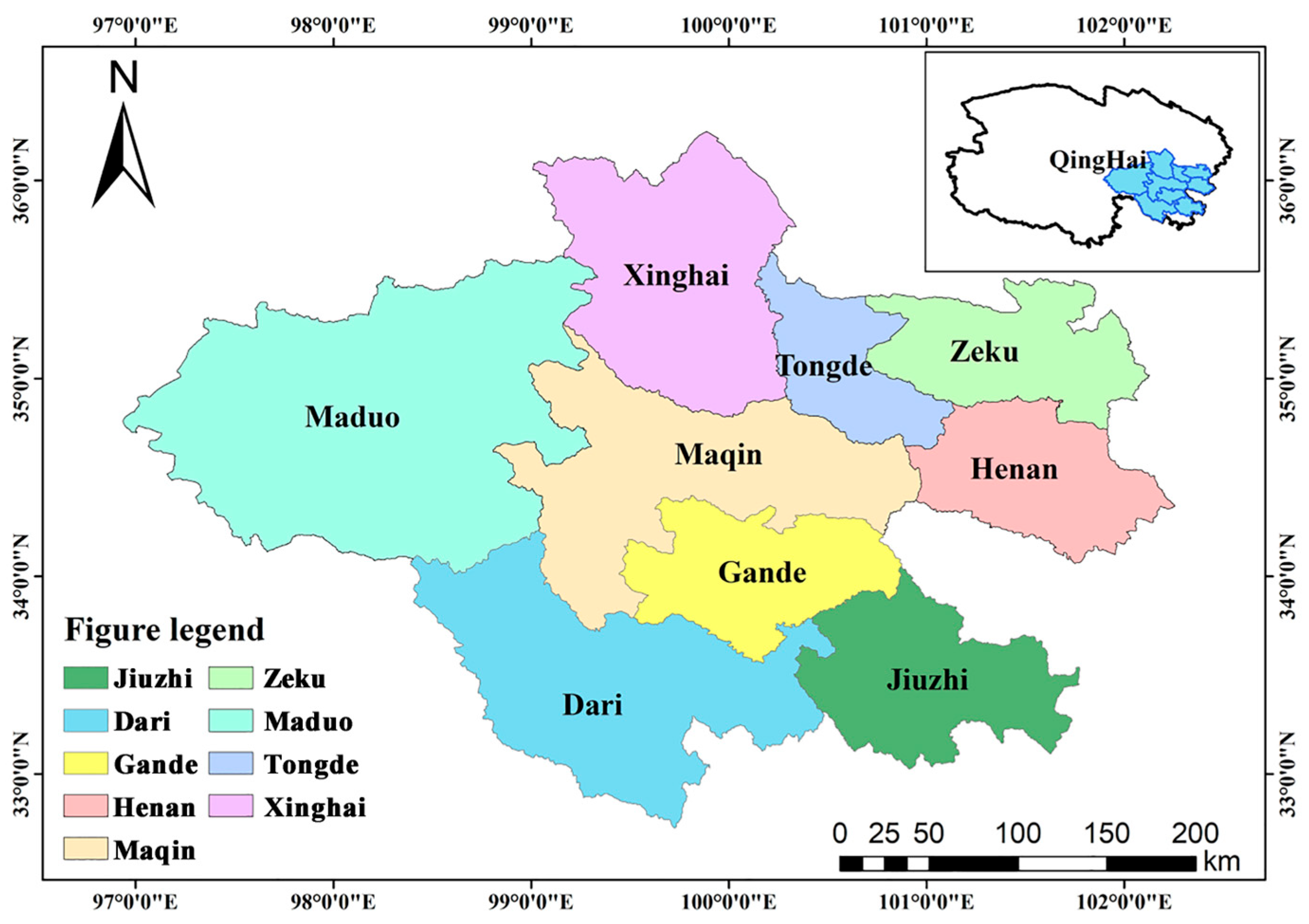


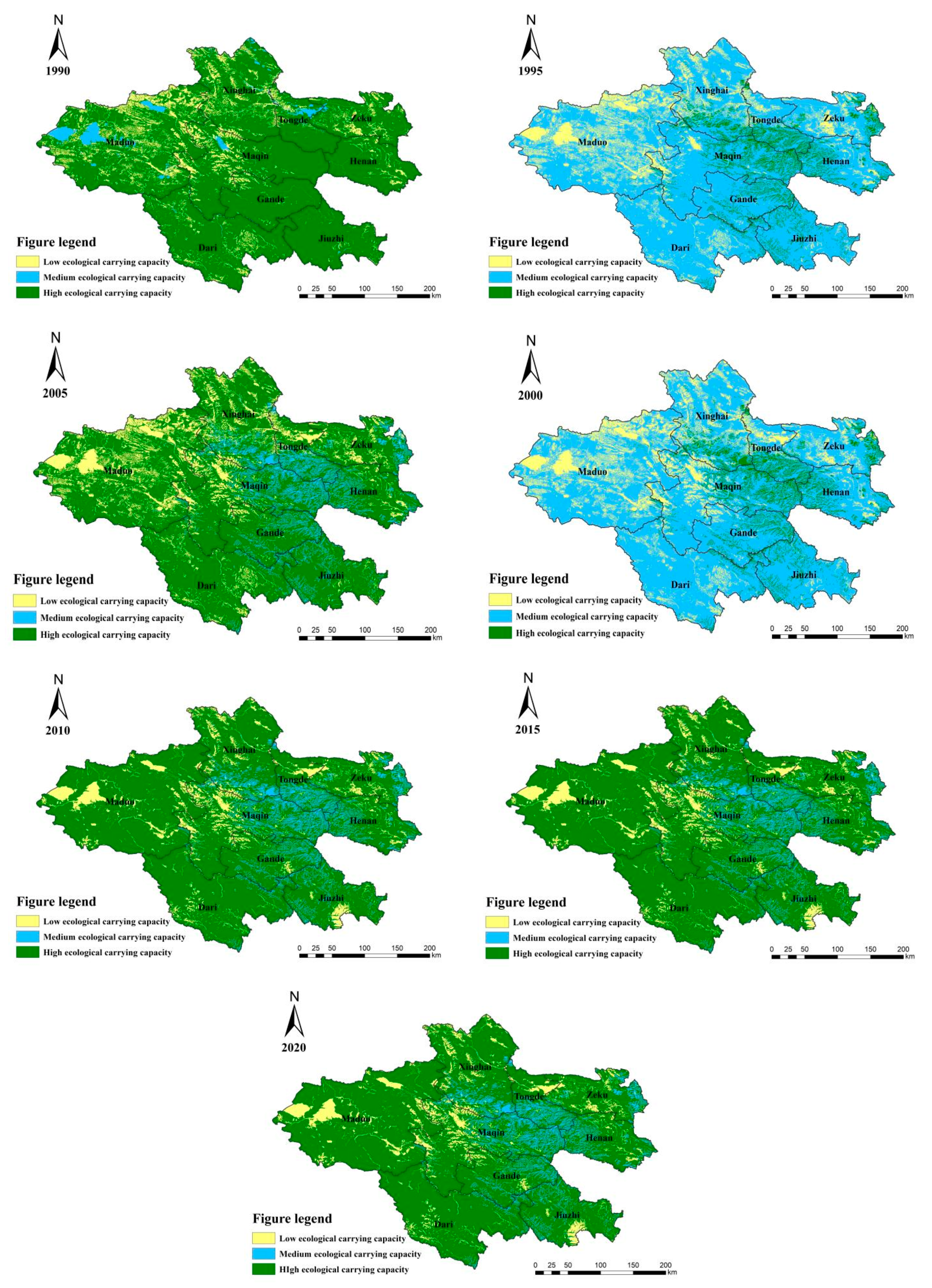
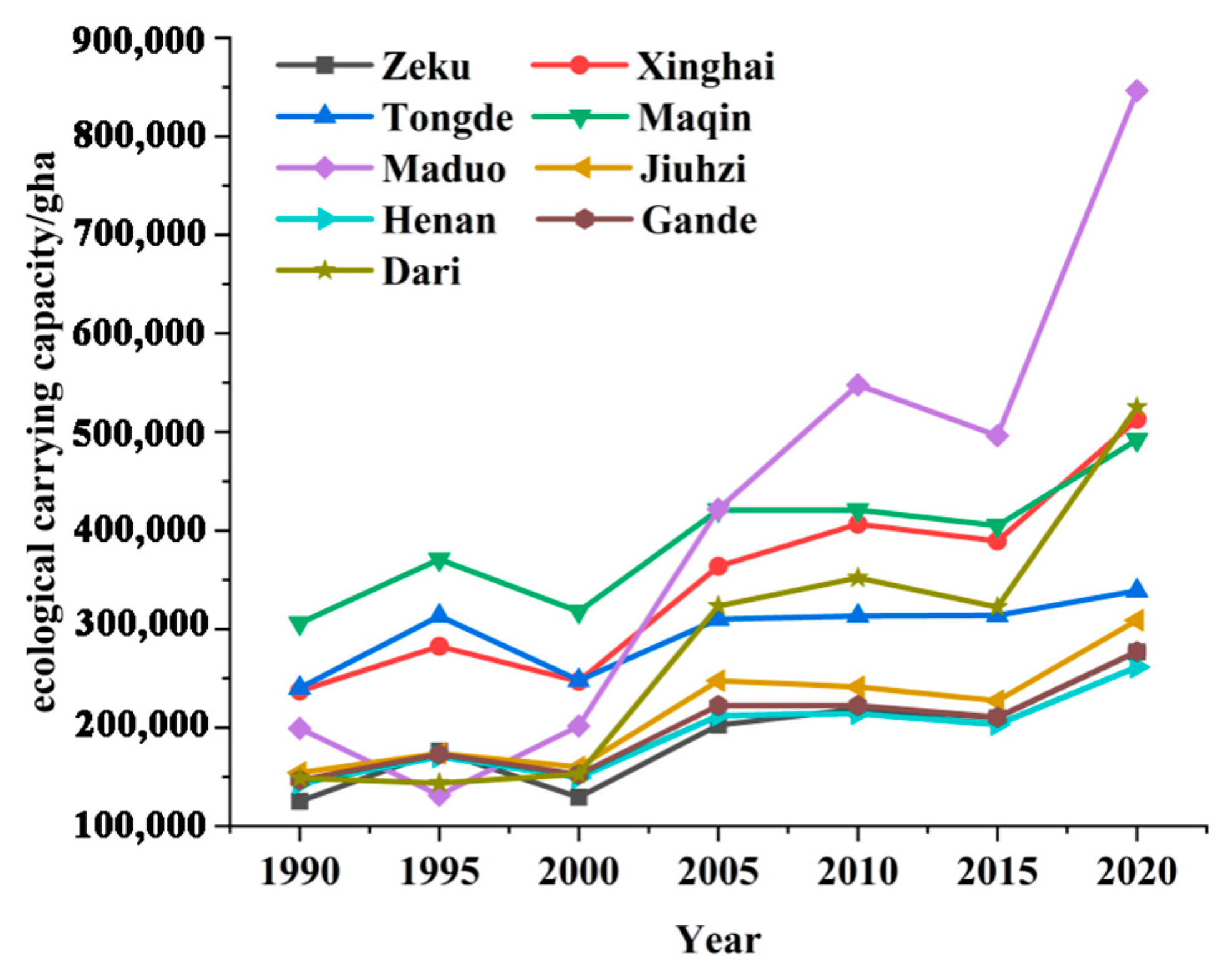
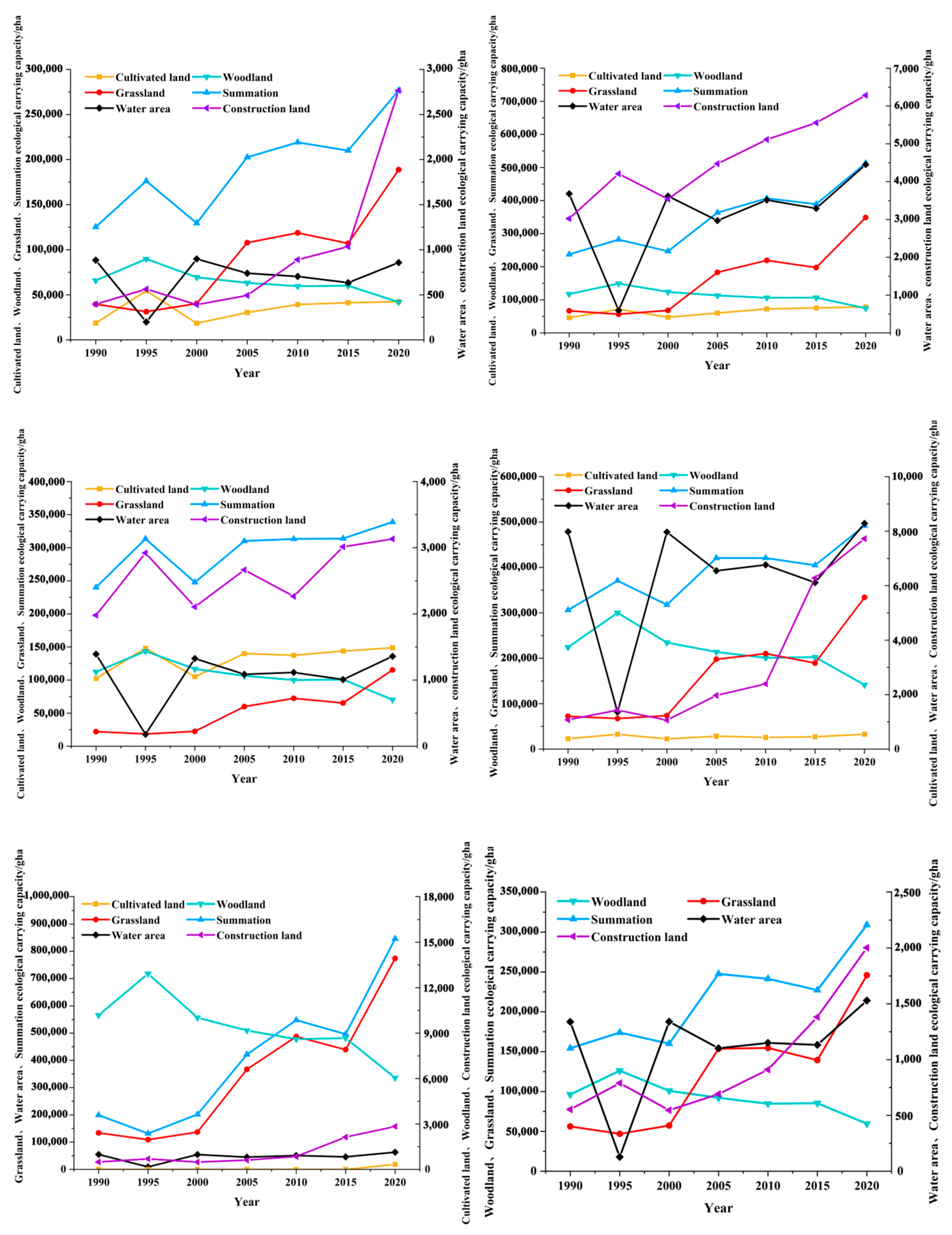
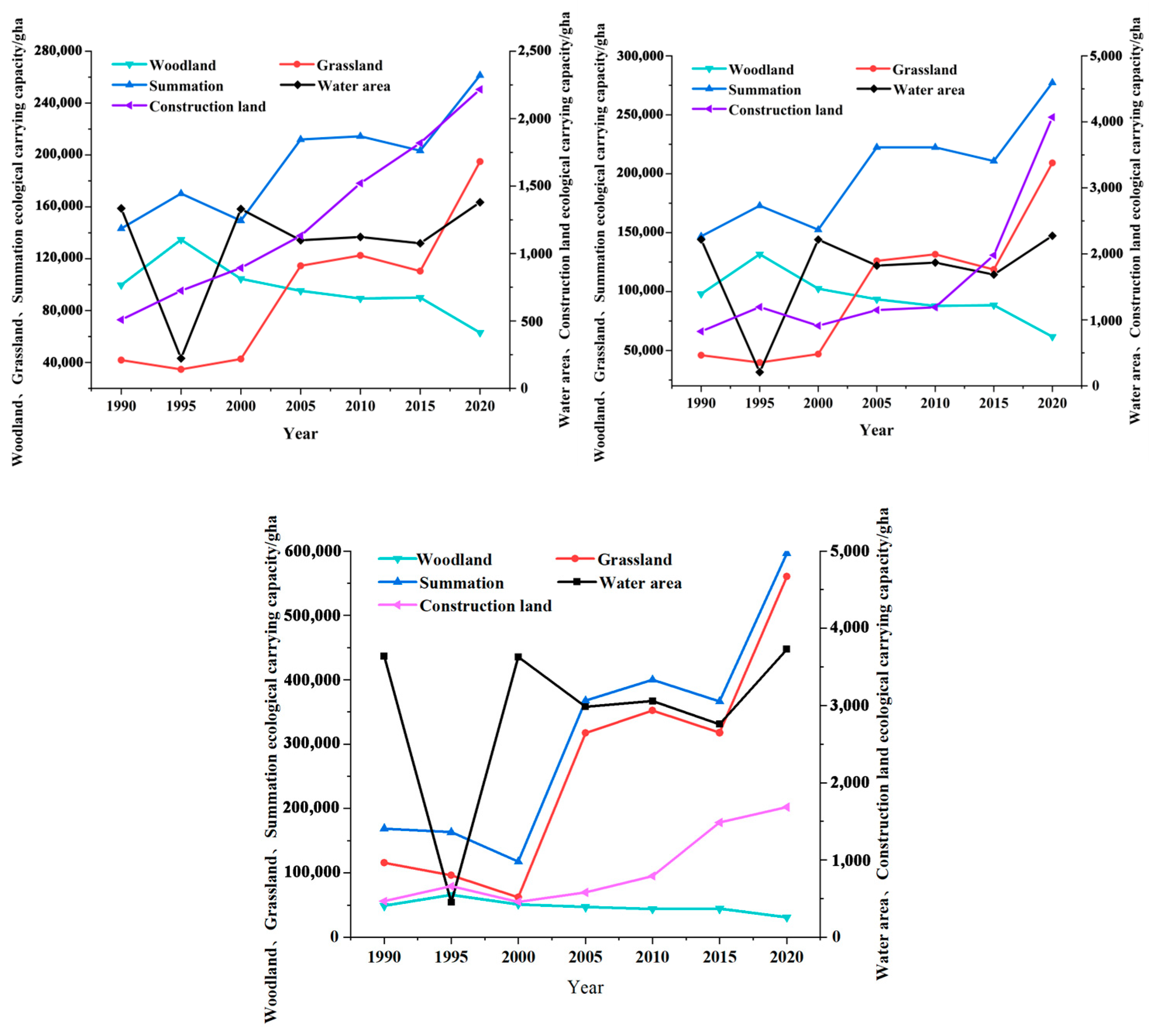
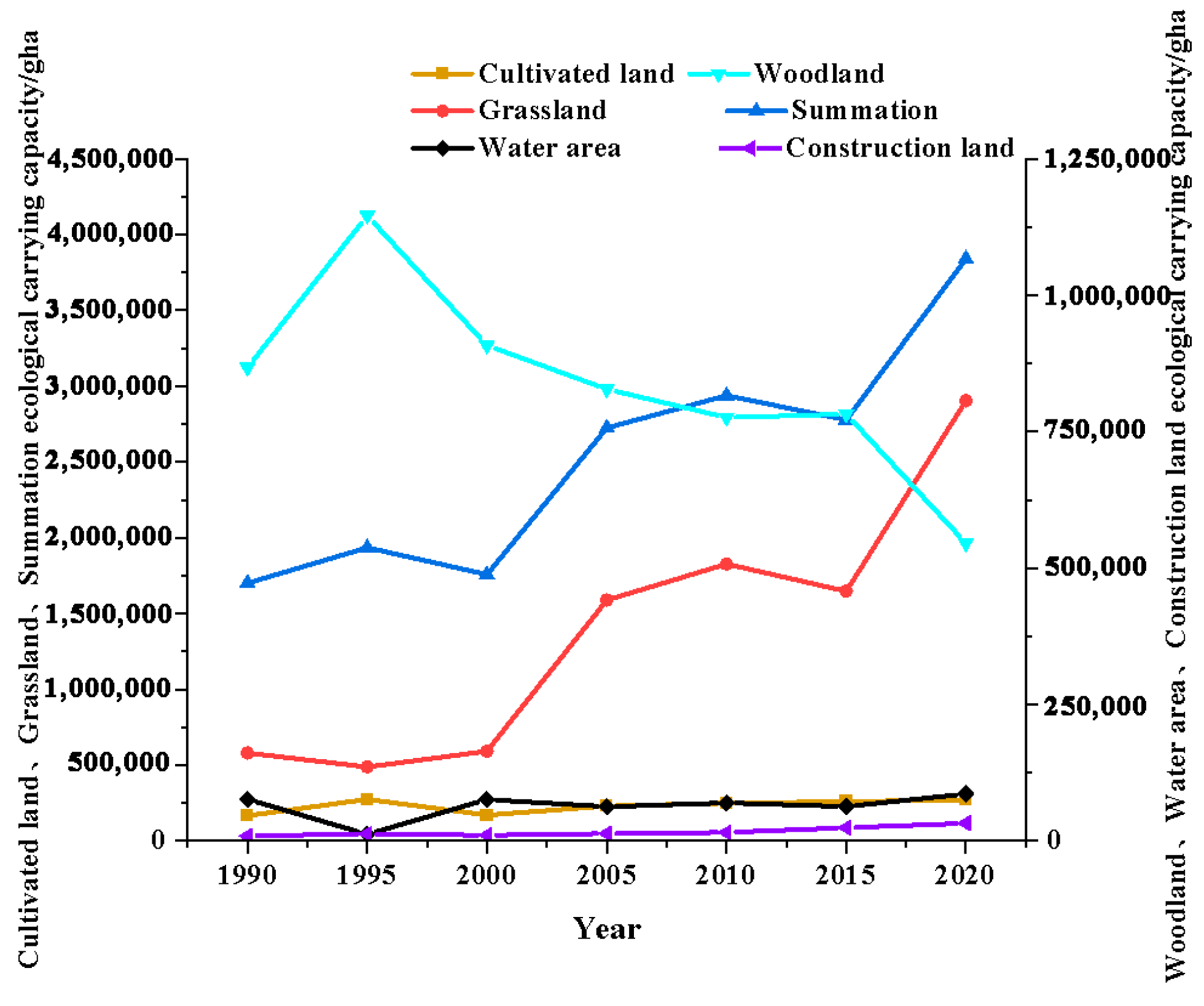
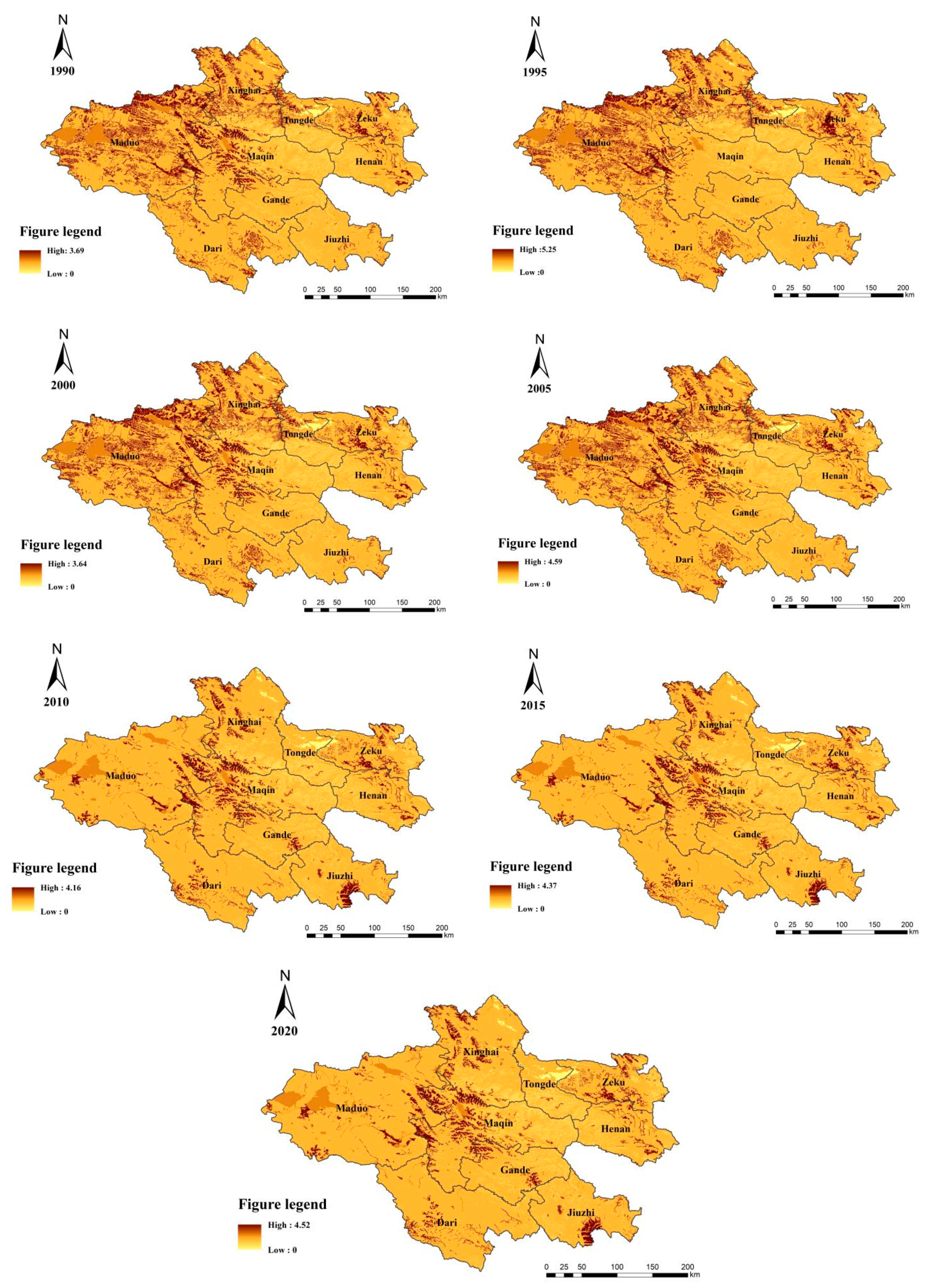
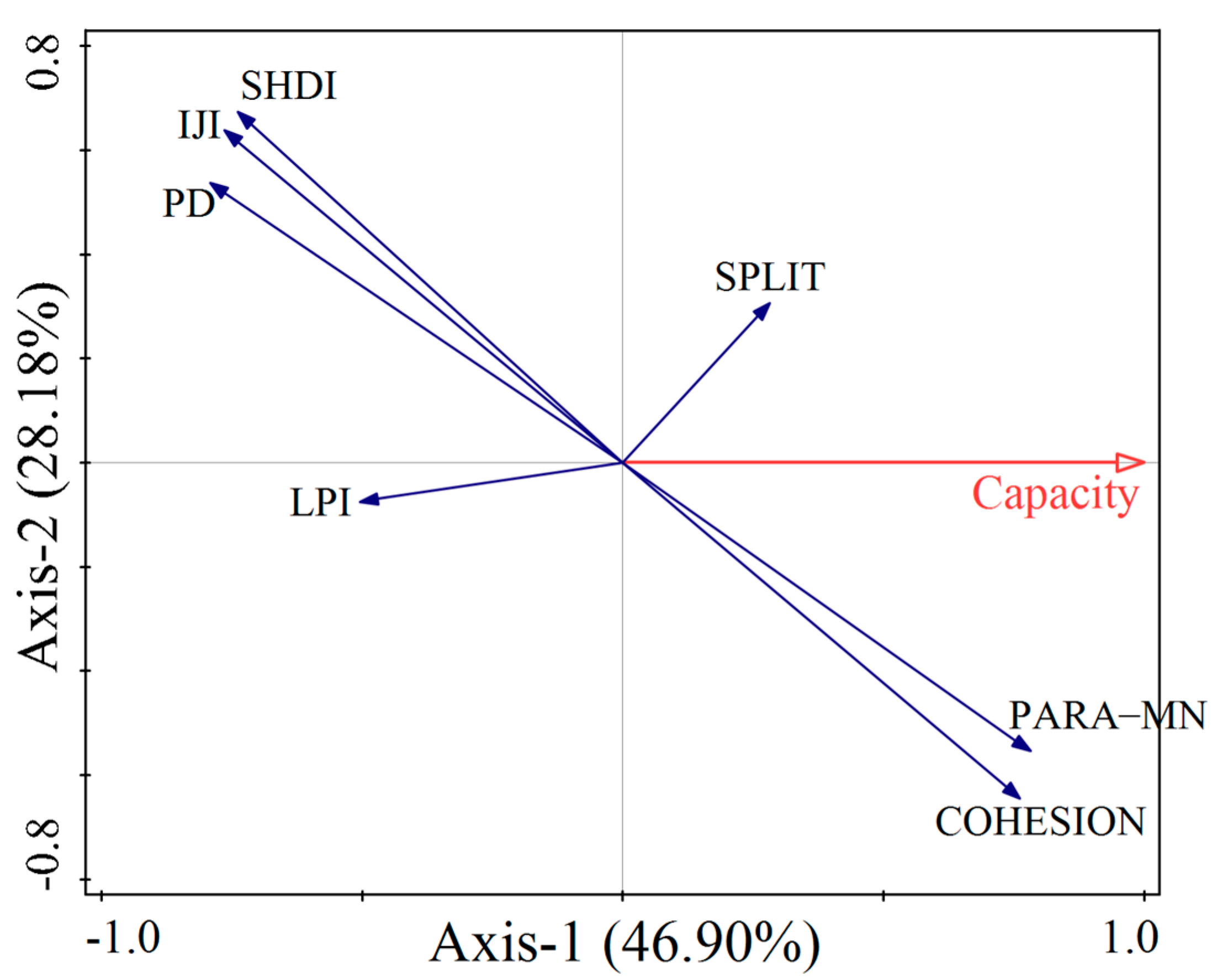
| Number | Landscape Type | Meaning |
|---|---|---|
| 1 | Cultivated land | Mainly includes paddy fields, dry land, etc. |
| 2 | Woodland | Refers to landscapes of trees, shrubs, etc., and all kinds of gardens. |
| 3 | Grassland | Mainly refers to landscapes of herbaceous plants. |
| 4 | Water area | Refers to natural waters and land for water conservancy facilities. |
| 5 | Construction land | Refers to urban and rural residential areas, industrial and mining, transportation, and other land. |
| 6 | Unused land | Refers to unused land, such as bare land. |
| Source | Year | Cultivated Land | Woodland | Grassland | Water Area | Construction Land | Unused Land |
|---|---|---|---|---|---|---|---|
| Wackernagel, 1996 [37] | 1990 | 2.22 | 1.32 | 0.47 | 0.36 | 2.22 | 1.32 |
| Living Planet Report, 1996 [38] | 1995 | 3.16 | 1.78 | 0.39 | 0.06 | 3.16 | 1.78 |
| Living Planet Report, 2001 [38] | 2000 | 2.19 | 1.38 | 0.48 | 0.36 | 2.19 | 1.38 |
| Living Planet Report, 2005 [38] | 2005 | 2.64 | 1.33 | 0.48 | 0.4 | 2.64 | 1.33 |
| Living Planet Report, 2008 [38] | 2010 | 2.39 | 1.25 | 0.51 | 0.41 | 2.39 | 1.25 |
| Living Planet Report, 2010 [38] | 2015, 2020 | 2.51 | 1.26 | 0.46 | 0.37 | 2.51 | 1.26 |
| Source | Year | Cultivated Land | Woodland | Grassland | Water Area | Construction Land | Unused Land |
|---|---|---|---|---|---|---|---|
| Wackernagel, 1996 [37] | 1990, 1995, 2000 | 1.66 | 0.91 | 0.19 | 1 | 1.66 | 0 |
| Liu M C, 2010 [36] | 2005, 2010, 2015 | 1.74 | 0.86 | 0.51 | 0.74 | 1.74 | 0 |
| Living Planet Report, 2002 [39] | 2020 | 1.8 | 0.6 | 0.9 | 1 | 1.8 | 0 |
| Year | PD | LPI | PARA_MN | IJI | COHESION | SPLIT | SHDI |
|---|---|---|---|---|---|---|---|
| 1990 | 0.2981 | 6.6743 | 153.4256 | 51.2339 | 99.8060 | 105.8569 | 1.8480 |
| 1995 | 0.2980 | 9.4702 | 152.7432 | 48.8812 | 99.8165 | 67.9519 | 1.7766 |
| 2000 | 0.2961 | 6.7271 | 152.5744 | 51.1416 | 99.8074 | 105.5252 | 1.8485 |
| 2005 | 0.2953 | 6.7370 | 151.1511 | 51.1664 | 99.8081 | 105.3229 | 1.8507 |
| 2010 | 0.2612 | 6.1206 | 162.0314 | 42.6178 | 99.8324 | 103.3618 | 1.6635 |
| 2015 | 0.2620 | 6.0998 | 160.7650 | 42.7795 | 99.8320 | 103.6758 | 1.6664 |
| 2020 | 0.2640 | 6.0999 | 163.2388 | 42.9080 | 99.8317 | 103.8283 | 1.6685 |
| Category | Indicators | Code |
|---|---|---|
| Natural factors | Average annual temperature | X1 |
| Annual precipitation | X2 | |
| Average annual evaporation | X3 | |
| Social factors | Population | X4 |
| Urban population | X5 | |
| Rural population | X6 | |
| GDP | X7 | |
| Per capita GDP | X8 | |
| Animal husbandry | X9 | |
| Total energy production | X10 | |
| Primary industry output | X11 | |
| Secondary industry output | X12 | |
| Tertiary industry output | X13 |
| Single Land Use Dynamic Attitude | Integrated Land Use Dynamic Attitude | |||||
|---|---|---|---|---|---|---|
| Arable Land | Woodland | Grassland | Water Area | Construction Land | Unused Land | |
| 1.06 | −0.15 × 10−2 | 0.26 | 0.33 | 6.22 | −1.59 | 0.214 |
| Earth Class | 1990 | 1995 | 2000 | 2005 | 2010 | 2015 | 2020 | Change Area | Annual Change Rate (%) |
|---|---|---|---|---|---|---|---|---|---|
| Cultivated land | 516.38 | 595.76 | 535.29 | 571.68 | 682.25 | 679.48 | 681.22 | 164.84 | 0.0053 |
| Woodland | 8205.92 | 8038.42 | 8216.24 | 8224.04 | 8201.31 | 8200.51 | 8202.28 | −3.64 | −0.0003 |
| Grassland | 73,865.94 | 74,980.26 | 73,829.37 | 73,769.55 | 79,809.51 | 79,769.57 | 79,722.97 | 5857.03 | 0.1987 |
| Water area | 2414.57 | 2340.09 | 2404.32 | 2415.84 | 2608.03 | 2625.71 | 2653.62 | 239.06 | 0.0081 |
| Construction land | 28.54 | 28.4 | 32.31 | 33.88 | 43.27 | 63.75 | 81.77 | 53.23 | 0.0017 |
| Unused land | 13,259.07 | 12,307.54 | 13,272.9 | 13,275.55 | 6946.2 | 6951.55 | 6947.95 | −6311.12 | −0.2140 |
| Year | Cultivated Land | Woodland | Grassland | Water Area | Construction Land | Unused Land |
|---|---|---|---|---|---|---|
| 1990 | 3.69 | 1.20 | 0.09 | 0.36 | 3.69 | 0 |
| 1995 | 5.25 | 1.62 | 0.07 | 0.06 | 5.25 | 0 |
| 2000 | 3.64 | 1.26 | 0.09 | 0.36 | 3.64 | 0 |
| 2005 | 4.59 | 1.14 | 0.24 | 0.30 | 4.59 | 0 |
| 2010 | 4.16 | 1.08 | 0.26 | 0.30 | 4.16 | 0 |
| 2015 | 4.37 | 1.08 | 0.23 | 0.27 | 4.37 | 0 |
| 2020 | 4.52 | 0.76 | 0.41 | 0.37 | 4.52 | 0 |
| Principal Components | Eigenvalue | Contribution Rate/% | Cumulative Contribution Rate/% |
|---|---|---|---|
| 1 | 10.404 | 80.034 | 80.034 |
| 2 | 1.447 | 11.133 | 91.167 |
| Driver Indicators | Principal Component 1 Loading Coefficient | Principal Component 2 Loading Coefficient |
|---|---|---|
| X1 | −0.047 | 0.886 |
| X2 | 0.634 | 0.643 |
| X3 | 0.972 | 0.17 |
| X4 | 0.922 | 0.074 |
| X5 | 0.992 | −0.04 |
| X6 | −0.705 | 0.302 |
| X7 | 0.989 | −0.118 |
| X8 | 0.99 | −0.12 |
| X9 | 0.975 | −0.005 |
| X10 | 0.94 | 0.235 |
| X11 | 0.988 | −0.092 |
| X12 | 0.99 | −0.113 |
| X13 | 0.988 | −0.128 |
| Year | Principal Component Y1 Score | Principal Component Y2 Score | Overall Score Y |
|---|---|---|---|
| 1990 | −3.05 | −0.34 | −2.48 |
| 1995 | −2.85 | −0.76 | −2.37 |
| 2000 | −2.28 | 0.39 | −1.79 |
| 2005 | −0.8 | 0.64 | −0.57 |
| 2010 | 0.95 | 1.84 | 0.96 |
| 2015 | 2.42 | −2 | 1.72 |
| 2020 | 5.61 | 0.23 | 4.52 |
Disclaimer/Publisher’s Note: The statements, opinions and data contained in all publications are solely those of the individual author(s) and contributor(s) and not of MDPI and/or the editor(s). MDPI and/or the editor(s) disclaim responsibility for any injury to people or property resulting from any ideas, methods, instructions or products referred to in the content. |
© 2024 by the authors. Licensee MDPI, Basel, Switzerland. This article is an open access article distributed under the terms and conditions of the Creative Commons Attribution (CC BY) license (https://creativecommons.org/licenses/by/4.0/).
Share and Cite
Lu, S.; Zhou, S.; Zhang, X.; Ma, X.; Tian, J.; Gong, Y.; Zheng, X.; Si, J.; Qin, B. Ecological Carrying Capacity and Driving Factors of the Source Region of the Yellow River in China over the Past 30 Years. Sustainability 2024, 16, 10194. https://doi.org/10.3390/su162310194
Lu S, Zhou S, Zhang X, Ma X, Tian J, Gong Y, Zheng X, Si J, Qin B. Ecological Carrying Capacity and Driving Factors of the Source Region of the Yellow River in China over the Past 30 Years. Sustainability. 2024; 16(23):10194. https://doi.org/10.3390/su162310194
Chicago/Turabian StyleLu, Sujin, Shipeng Zhou, Xiaoyan Zhang, Xujie Ma, Jiawei Tian, Yanhong Gong, Xiaojing Zheng, Jianhua Si, and Biyu Qin. 2024. "Ecological Carrying Capacity and Driving Factors of the Source Region of the Yellow River in China over the Past 30 Years" Sustainability 16, no. 23: 10194. https://doi.org/10.3390/su162310194
APA StyleLu, S., Zhou, S., Zhang, X., Ma, X., Tian, J., Gong, Y., Zheng, X., Si, J., & Qin, B. (2024). Ecological Carrying Capacity and Driving Factors of the Source Region of the Yellow River in China over the Past 30 Years. Sustainability, 16(23), 10194. https://doi.org/10.3390/su162310194






